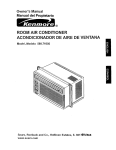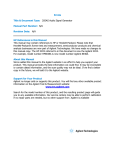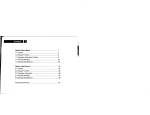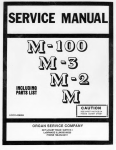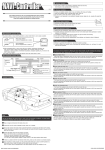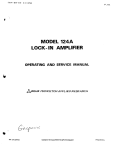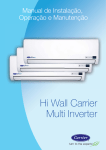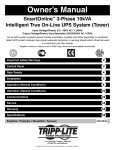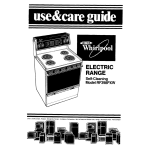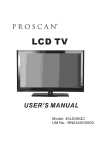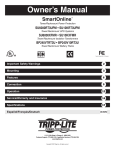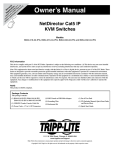Download Tripp Lite SmartOnline SU6K User's Manual
Transcript
9 TRIPPaUTE POWER PRorEcTloN N 1111 W. 35th Street Chlcago, IL 60609 USA Customer Support: (773) 869-1234 Application Services: (773) 869-1236 www.tripplite.com 1 Capyrighl 0 MOI Tripp tile. All ri@umrved. Smam3nlieN is a rcgisterrd trademark of Tripp Lite. This manual contains important instructions and warnings that should be followed during the installation, operation and storage of all Tripp Lite SmartOnline UPS Systems. UPS Location Warnings Install your UPS indoors, away from excess moisture or heat, dust or direct sunlight. Install your UPS in a structurally sound area. Your UPS is extremely heavy; take care when moving and lifting the unit. Only operate your UPS at indoor temperatures between 32" F and 104" F (between 0"C and 40" C). For best results, keep indoor temperatures between 62" F and 84" F (between 17" C and 29" C). Leave adequate space around all sides of the UPS for proper ventilation: 12 in. (30 cm.) clearance at the rear; 4 in. (10 cm.) at sides and on top. Do not install the UPS near magnetic storage media, as this may result in data conuption. UPS Connection Warnings The power supply for this unit must be single phase rated in accordance with the equipment nameplate. It also must be suitably grounded. Equipment Connection Warnings Do not use M p p Lite UPS Systems in life support applications in which a malfunction or failure of a Tripp Lite UPS System could cause failure or significantly alter the performance of a life support device. Connect your UPS's Grounding Terminal to a grounding electrode conductor. The SUGK contains its own energy source (battery). The output terminals may be live even when the UPS is not connected to a n AC supply. Battery Warnings Your UPS does not require routine maintenance. Do not open your UPS for any reason. There are no user-serviceable parts inside. Because the batteries present a risk of electrical shock and bum from high shortcircuit current, batteries should be changed only by trained service personnel observing proper precautions. Replace the existing batteries with the same number and type of new batteries [(Sealed Lead-Acid) SU6K (twenty 12V/7AH batteries); SUlOK (forty 12V/7AH batteries)]. Do not open the batteries. Do not short or bridge the battery terminals with any object. The UPS batteries are recyclable. Refer to local codes for disposal requirements, or if in the USA call 1-800-SAV-LEAD (1-800-728-5323) for complete recycling information. Do not dispose of the batteries in a fire. Connect only Tripp Lite battery packs to your UPS's external battery connectors. Do not operate your UPS without batteries. Fuses should be replaced only by factory authorized personnel. Blown fuses should be replaced only with fuses of the same number and type. Potentially lethal voltages exist within this unit a s long a s the battery supply is connected. Service and repair should be done only by trained personnel. During any service work, the UPS should be tumed off or put into manual bypass (see pg. 12). During "hot-swap" battery replacement (when the UPS is on manual bypass and connected equipment is turned ON) your UPS will be unable to provide battery backup in the event of a blackout. Do not connect or disconnect the battery cabinets while the UPS is operating from the battery supply or when the unit is not in bypass mode. Familiarize yourself with the location and function of the front and rear panel features before installing and operating your UPS. FRONT PANEL 0 0 0 0 UPS SYSTEM , 5 1. "ON/OFFn Switch: This momentary rocker switch turns the UPS System's inverter ON and OFF. 2. "SELECT" Button: This button performs two functions: it allows you to browse through different power readings on the LCD Display by momentarily pressing the button; it also allows you to silence the UPS alarm by pressing and holding the button for 3 seconds. 3. LCD Display: This backlit (16x2 character) dot matrix display indicates a wide range of UPS operating conditions and diagnostic data. It will illuminate after you have properly completed installation and start-up and after the "ON/OFFmSwitch is turned ON. 4. " I / P (Input) LED: This green light will illuminate constantly to indicate a n AC input supply is present. 5. "AC/DC" (Converter) LED: This green light will illuminate constantly to indicate the UPS's AC/DC converter is activated. 6. "DC/ACW(Inverter) LED:This green light will illuminate constantly to indicate the UPS's DC/AC inverter is activated. 7. " O / P (Output) LED: This green light will illuminate constantly to indicate your UPS is supplying AC power to connected equipment. 8. "BYPASS"LED: This green light will illuminate when the UPS is providing filtered mains powerwithout engaging its converter or inverter. Connected equipment will not receive battery power in the event of a blackout. 9. "BATTERY" LED: This red light will illuminate when the UPS is discharging the battery to provide connected equipment with AC power. An alarm will sound which can be cancelled by pressing and holding the "SELECT" switch for 3 seconds. The alarm will be cancelled, but the LED will remain illuminated. SUBP REAR PANELS 1. Manual Bypass Switch:This red and yellow dial is used in one step of putting the UPS in "BYPASS"mode, which must be done before performingany maintenance on the UPS with the connected load supported. (See page 12 for step-by-step instructions for going into "BYPASS.")While this switch is on "BYPASS." connected equipment will receive filtered AC mains power, but will not receive battery power in the event of a blackout. 2. Input Terminal Block: Use these terminals to connect your UPS to the AC main power input. Unscrew and remove terminal block plate for access. The optional SUBP battery pack's IEC-320 connector accepts i t s charger's input power cord. 3. Output Terminal Block: Use these terminals to connect your UPS to equipment. A plate covering the terminal block must be unscrewed and removed for access. 4. Input Voltage Select Terminal Block: Use these terminals to set your UPS's to receive your 208V AC or 240V AC line voltage. A plate covering the terminal block must be unscrewed and removed for access. 5. External Battery Connector: Use this to connect Tripp Lite Battery Packs. The SUlOK requires a SUlOKBP or SUBP to operate; additional SUBP's can be added to SU6K or SUlOK systems for extra runtime. Refer to instructions available with the optional SUBP Battery Pack for connection instructions and safety warnings. 6. Exhaust Fan: This cools and ventilates the inside of the UPS. 7. AS-400 Interface Port: This female DB9 port connects your UPS to a n IBM AS-400 computer interface via the AS-400 Cable included. It uses AS-400 communications to report UPS status and power conditions. Using this port, an IBMAS-400 computer can automatically save open files and shut down i t s operating system during a blackout. See "Communications." pg. 13. for details. 8. "Smart" -232 Interface Port: This female DB9 port connects your UPS to a workstation or server. It uses RS-232 communications to report UPS and power conditions. It is used with Tripp Lite software and the included RS-232 Cable to monitor and manage network power and to automatically save open files and shut down equipment during a blackout. See "Communications." pg. 13. for details. 9. Dry Contact Interface Port: This female DB9 port sends contact-closure signals to indicate line-fail and low-battery status. See "Communications." pg. 14, for details. 10. Accessory Slot: Remove the small cover panel and use optional accessories to remotely control and monitor your UPS. Contact Tripp Lite Customer Support for more information and a Hst of available SNMP. network management and connectivity products. 11. "BatteryStart"Switch:This momentaryrocker swltch allowsyou to "cold-start" your UPS and use it a s a stand-alone power source when utility-supplied AC power is not present. The switch enables the UPS's DC/AC Inverter. Before "cold-starling" your UPS, make sure your UPS and external battery cabinets are properly installed. Press and hold the "Battery Start" Switch and then press the "ON/OFF" switch to turn your UPS ON. To turn it OFF after "cold-start," press the "ON/OFF" Switch. 12. Battery Fuses (SU6K & SUBP's Only):The 30A/600V fuses protect your connected battery or battery bank. 13. AC Input Breakers: One double-pole circuit breaker controls input power to the UPS. 14. AC Output Breaker: Triple-pole circuit breakers control output power from the UPS. 15. Remote "Emergency Power OFF" Connector: This R J l l modular jack allows remote emergency shutdown. See "Communications,"pg. 14. for details. 16. Inverter Operation DIP Switches: Behind this removable panel are four DIP Switches that should be set to match your input voltage and input frequency. Your input voltage and frequency DIP switch settings MUST match your input. Your UPS WILL NOT CONVERT the voltage or frequency. 17. Grounding Terminal: This terminal connects to a grounding electrode conductor. IT IS NOT SAFE TO OPERATE YOUR UPS WITHOUT CONNECTING IT. The recommended conductor size is 8 AWG based on the UL 1778 standard. 18. Stabiltzers: These supports extend to keep your UPS from rolling or tipping. INVERTER OPERATION DIP SWITCH SETTINGS (SUIOKPM SHOWN) Using a small tool, set the four Inverter Operation DIP Switches (located on the rear panel of your UPS, see pg. 4-5 for location) to match your input voltage, input frequency a n d desired operational mode. InDut Voltage Selection (D~P switch& # 1 ~r #2) (Input Voltage Select Terminal Block) These DIP switches and the Input Terminal Select Block must BOTH be set to match your input voltage. Your UPS WILL NOT CONVERT the voltage. J n ~ uVolt= t 240V DIP Switch Position Input Voltage Select Terminal Block #1 DOWN & #2 DOWN Invut Frequencv Selection (DIP Switch #3) Your Input Frequency setting MUST match your input frequency. Your UPS WILL NOT CONVERT the frequency. Input Frequency DIP Switch Position 6 0 Hz #3 DOWN Overational Mode Selection (DIP Switch #4) The "On-Line" Mode provides on-line operation with zero transfer time. The "Economy" Mode provides line-interactive operation for increased efficiency when on-line protection is unnecessary, thus reducing operating costs without affecting your UPS'S output reliability during a power outage. Input Frequency DIP Switch Position On-Line #4 UP Economy #4 DOWN UPS LOCATION Move your UPS over short distances using its wheels. Stabilize the UPS by releasing the stabilizers on each side of the unit. NOTE: Do not stack the UPS Systems or external battery packs. INPUTAND OUTPUT CONNECTION WIRING SELECTION Choose appropriate cabling (depending on current carried; see chart below) to connect your UPS to an AC power supply and your equipment to your UPS: SU6K RATED INPUT CURRENT 208/240 I0 3 Wlre 30A 8 AWG (8mm1/60"C) RATED OUTPW CURRENT 120-208/240V 1 0 3 Wlre 30A 8 AWG (8mm1/6W) RATED OUE'UT CURRENT 120V 103Wlre 2 x 32A 6 AWG [14rnm1/60"C) OUTPUT PROTECnON CIRCurr 32A SU IOK 50A6AWG (14mrn1/60"C) 50A6AWG (14mm2/60"C) 2 x 50A4 AWG (22mmv/6(PC) 63A MODEL WIRING CONNECTIONS Connect your wiring to the input and output terminal blocks located on the lower rear panel of your UPS (seefigure below). Before cable connection, turn the UPS OFF and pull out the fuse holder. Ensure the cable is fitted with a cable sleeve and is secured by a connector clamp. The minimum tightening torque is 35 Ibs. per square inch. Connect the ground wire (typically colored green and yellow) to the terminal marked with the letter "G." Cable Connection for 6kVA or lOkVA Output (6kVAshown) AC INPUT 156-264V50/60HZ CAUTION: Observe the appropriate cable connection regulations 1e.g. National Electrical Code (NEC) in the U.S.] at all times. Using cables of improper size may damage your equipment and cause fire hazards. Ground the UPS and the load equipment a s shown in the figure. LUOV GROUND CONNECTION UPS TOTH,"AEkDING (GROUND) + LOAD 1 LOAD 2 LOAD 3 EXTERNAL BATTERY PACK CONNECTION (SUGK: Optional; SU1OK: Required) Since SUGK models contain internal batteries, connecting external battery packs (to extend runtime) is optional. SUlOKPM models, however. do not have internal batteries and require an external battery pack connection to a SUlOKBP or a SUBP. Using the supplied battery connection cable, insert one end into the External Battery Connector on the rear panel of your UPS and the other end into the Battery Output Connector on the rear panel of the external battery pack. Use the plug on either end of the supplied cable, but make sure that it is fully inserted into the connector. See figure below for daisy-chaining one or more external battery packs to your UPS. SUBP SUlOKBP SUlOKPM Note: Optional Tripp Lite external battery packs (SUBP's) feature individual 120V AC input line cords and individual internal battery chargers. By adding multiple SUBP's individually connected to 120V AC input, the recharge time of a battery system will be dramatically reduced a s compared to systems relying on only the UPS'S main charger. While adding SUBP's without connecting their chargers will increase a battery system's reserve capacity, this will also increase the system's overall recharge time. See the figure to the Acmpu, avo right for the schematic diagram of the SUBP external battery pack. 1 BArrERY FUSE REPLACEMENT THE DIAORAU OF THE EXTENSIBLE BATTERY CABINET If one of your fuses has blown, you will notice no output voltage at zero load. Blown fuses should be replaced as shown in the diagram on the right. Since SUGK models f contain internal batteries, the battery fuse holders are located on the rear panel of the UPS. Since SUlOK models operate solely from external batteries, the battery fuse holders are located on the rear panel of the external battery pack(s). Note: SUGK models also support connections to optional external battery packs, which may require battery fuse replacement. BA77ERY CONDITION VERIFICATION When the UPS is operating from battery power, the alarm and LCD Display will both alert you to the UPS battery's charge condition. Batterv Charge Condition FULL Alarm Short Beep (every 2 seconds) LOW Short Beep (every 1/2 second) UNDER Continuous Beep E D Dis~lav ON BAlTERY BA'IT = XXV W o BA'ITERY LOW B A T = XXV W o BA'ITERY UNDER SHUT DOWN INITIAL BAVERY CHARGING (OPTIONAL) Your UPS System's battery is fully charged prior to shipping. However, if your UPS has been stored for an extended period, recharge its battery for 8 hours. To charge, turn on the AC Input Breaker. The LCD Display will illuminate and indicate "ON BYPASS." DO NOT turn on the AC Output Breaker to apply the load until the battery is fully charged. Once the UPS is in use, it will charge the batteries and maintain the charge level automatically. TURNING THE UPS ON Make sure the UPS is properly installed (see Installation section) and the Manual Bypass Key is set to NORMAL. Turn the AC Input Circuit Breaker ON, then turn the Output Circuit Breakers ON. If your AC input is providing power normally within your selected range (see Input Voltage Selection, pg. 6, and Specs, pg. 17). your connected load will energize. However, the UPS'S inverter is not yet on. Press the front "ON/OFF" switch ON to begin inverter operation. If your AC input is not providing power normally, you have the option of starting from battery. (Your battery must be at least partially charged for this operation to succeed.) Press and hold both the "Battery Start" switch and the "ON/OFF" switch for three seconds to start your UPS in "ON BA'ITERY mode. Note that some electronic equipment may draw more amps during startup: when starting from battery, consider reducing the initial load on the UPS. The UPS will perform a brief self-test and show the results on the LCD Display. (See Self-Test section, pg. 10, for display sequence.) After a successful self-test, the UPS will provide AC power from the inverter to your load. TURNING THE UPS OFF Press the front "ON/OFFmSwitch OFF. Your load will still be energized. The inverter is now off, but your UPS is not fully deactivated. The LCD Display will show "ON BYPASS." Turn the AC Input and Output Circuit Breakers OFF. Your load will no longer be energized, and the LCD display will be dark. SELF-TESTING When you turn the UPS ON, it will perform a brief (about 25 second) self-test. See figure below for display sequence.' 'Note: ~ s t a r t i n g f i o mbattery, the BATIERY LED will be Ut and the I / P and BYPASS LED5 wlll MI. TheJInd LCD dlsplay In (he diagram below appears when the LlPS b operating normally under utfllty-supplledAC Input power. SELECT FREQ OUT . XXHz Sltll~lOlllll~ ,,,, UPS SYSTEM A SELECT INPUT AC OK UPS SYSTEM $! OFF UPS SYSTEM UPS SYSTEM UPS SYSTEM UPS SYSTEM SELECT AC/DC O K C U K S E R U L L UPS SYSTEM UPS SYSTEM -3 INVERTER T E S T k~nloniini UPS SYSTEM P SELECT ziii$ + unrm 1 UPS SYSTEM LCD DISPLAY SELECT SWITCH Momentarily press the "SELECT" switch on the front panel to browse through different power readings on the LCD Display. The LCD Display will show which one of four operational modes your UPS is currently in: Normal, Economy, On-Battery, or Bypass. Also, a s you press the "SELECT"switch, the LCD Display will browse through load. input, bypass, output and battery conditions. "ON-BATTERY" MODE OPERATION "NORMAL"MODE OPERATION "ECONOMY' MODE OPERATION "ON BYPASS" MODE OPERATION OPERATION ON BYPASS-VOLTAGE OUT OF RANGE While in Bypass Mode, the UPS monitors the input voltage, which on Bypass equals the output voltage. If the output voltage passes out of an acceptable range (between 15%higher and 20% lower than nominal), the UPS displays the condition on its LCD and stops supplying output power to its load. If power levels return to an acceptable level. the UPS resumes supplying power to the load, and its LCD reports that output voltage was too high or too low a t one time, but has returned to nominal. Bypass Voltage Condition LCD Display Message > 15Oh Higher than Nominal BYPASS AC TOO HI >20% Lower than Nominal BYPASS AC TOO M Was Too High. Now Nominal BYPASS AC WAS HI Was Too Low. Now Nominal BYPASS AC WAS LO OPERATION ON OVERLOAD When the UPS detects an output overload, it will commence a countdown (the length of time depending on the severity of the overload). If the UPS is still overloaded a t the end of the countdown, the UPS will automatically shut down and go into Bypass Mode. LCD Display Message Countdown to Shutdown 125% Overload 102% Load=XXXOhX.XXKW 1 minute 125% - 150% Overload 125% Load=XXXOh XXXKW 30 seconds >150% Overload 150% Load=XXXOh X.XXKW 2 seconds Overload Condition 102% - 11 BATERY CHARGE WARNlNGS Since your UPS can provide battery backup only for a s long a s the batteries remain charged, these warnings should be acted on immediately. Battery Charge Warning LCD Display Message Battery charge nearly depleted BATTERYLOW AC/DC charger not operating CHARGERFAILURE! OPERATION UNDER SHUTDOWN Your UPS will shut down and the LCD will display a message if it detects one of the following conditions. Note: For all conditions, the "Input," "Output" and "Bypass" LEDs will be illuminated. Condition Extended Overload (>1500%) LCD Display Message OVERLOAD 150% SHUTDOWN SHORTClRCUlTl SHUTDOWN REMOTE SHUTDOWN EMERGENCYSTOP! SHUTDOWN INVERTERTOOLO SHUTDOWN INVERTERTOO HI SHUTDOWN DC BUS +/- HIGH/LOW SHUTDOWN OVERTEMPERA'IURE SHUTDOWN Output Short Circuit Remote Shutdown Command (FROM DB9 INTERFACE) Remote Shutdown Command (from RJ 11 interface) Internal Faults OPERATION OF MANUAL BYPASS SWITCH Turn this switch to "BYPASS" before performing any maintenance on the UPS with the connected load supported. Connected equipment will receive filtered AC mains power, b u t will not receive battery power in the event of a blackout. UAHUAL B Y P A S S SWITCH - A C ~ N ~ U ~ l ~ ~ U TFROU E ~ W E *C L I N ~ SWITCHING UPS TO "BYPASS" MODE Turn the "ON/OFFn Switch OFF. (LCD will read "ON BYPASS.") Turn the "Manual Bypass" Switch clockwise from NORMAL to BYPASS. Turn the AC Input Circuit Breaker OFF. Open battery fuse holders and remove the battery fuses from all battery packs and from all SUGK models. SWITCHING UPS TO "NORMAL" MODE Replace all battery fuses in the battery fuse holders and close the battery fuse holders. Turn the AC Input Circuit Breaker ON. Turn the "Manual Bypass" Switch counterclockwise from BYPASS back to NORMAL. Turn the "ON/OFF Switch ON. RS-232 INTERFACE This female DB9 port connects your UPS via an RS-232 cable to a workstation or server equipped with Tripp Lite software. The port uses RS-232 communications to report UPS status and power conditions. Using this port, M p p Lite software can monitor and manage network power and automatically save open files and shut down equipment during a blackout. Contact M p p Lite Customer Support at (773) 869-1233 for information on available SNMP, network management and connectivity software and products. RS-232 signals and operations include: load level, battery status, battery level. operation mode, AC input voltage, AC output voltage, AC input frequency. temperature inside unit, set shut-down delay time, enable/disable alarm and remote shutdown. Hardware: Baud Rate: Data Length: Stop Bit: Parity: 2400 BPS 8 bits 1 bit NONE Pin assienment; Pin 2: TXD (Transmit Data) RXD (ReceivingData) Pin 3: Pin 5: GND (Signal Ground) AS-400 INTERFACE: This female DB9 port connects your UPS to an IBM AS-400 computer via the included AS-400 cable. The port uses AS-400 communications to report UPS status. It can be used to allow an AS-400 to automatically save open files and shut down its operating system during a blackout. AS-400 protocol includes: operation on inverter, operation on AC power supply, operation on battery and low battery alarm. pin assimment: Pin 5: Common Pin 6: Operation on AC power supply Pin 7: Low battery alarm Pin 8: Operation on inverter Pin 9: Operation on battery LOW BATTERY INVERTER I E l 1941 I AS-400 INTERFACE TABLE Pin 6,5 Pin 7.5 Pin 8.5 Pin 9,5 ON ON Battery OFF Low Battery OFF ON ON ON Direct Mains Supply ON OFF OFF OFF Inverter OFF * ON * *Inactive:may be in either state. 13 DRY CONTACT INTERFACE: This female DB9 contact-closure port allows your UPS to send contact-closure signals to indicate that it is on battery back-up mode and if its batteries are running low. The port can also receive a remote shutdown signal. Pin assipnment; - lmin.U.3mA LOW BATTERY I b NC If I COY I C REMOTE SHUTDOWN SIGNAL FROM EXTERNAL 1 I SIGNALFROM COMPUTER .' I ! MAXIMUM CAPACITY OF DRY CONTACT: AC250Vn4 DC30vnA DRY CONTACT INTERFACE TABLE UPS Operating Mode Pin 8,3 Pin 1,3 Normal OPEN OPEN Back Up CLOSE Low Battery CLOSE CLOSE * Inactive: may be in either state. REMOTE EMERGENCY POWER OFF: This R J 11 modular jack allows remote emergency shutdown. Pin assignment lSU6K Shown] Pin 1 If there is a short between pins 2 and 3, 2 and 5, 4 and 5, or 3 and 4, the UPS will power off. Service Your Smartonline UPS is covered by the 2-year limited warranty period described below. A variety of service contracts is also available from Tripp Lite. including startup service contracts and 3- to 5-year SafeSure on-site service contracts. For more information, call Tripp Lite Customer Service at (773)869-1233. 2-Year Limited Warranty TRlPP LlTE warrants tls products tncludtng batteries to be free from defects In materials and workmanship for a period of two years from the date of initial purchase. After 90 days from the d.lte of purchase, TRIPP L m ' s obli@ition undcr this warranty is llm~tedto replacing parts on suchdcfcchve products. Toobtain sen ~ c cunder thls warranty, you must callTRlPP LlTEoran authorized TRlPP LITE scrvicccenter. Producls must be returned to TRlPP L m or an authorized TRIPP LITE service center with transportallon chnmes .. prcpa~dand must be acmmpanted bv a brief description of the problem encounlered and proof of date and place of purchase. This warranty does not apply to equipment Lhich has been damaged b v accidenl, ncaligence or misapplication or has been altered or modified i n any way. This warranh,, applies only to the original purchaser who must havc pr&ly registercd'ihe product within 10 days of purchase. . . . . .. T h e w a r r a n h e s o f a l l T R I P P L ~ s u p p r e s ~ n uandvold ll ~fthey havebeenconnected totheoutputof any UPSsystem Thcwarranhes of all TRIPP LlTE UPS Splems are null and vold ~fil surge suppressor has been connected to its output receptacles. EXCEPT AS PROVIDED HEREIN, TRrPP LlTE MAKES N O WARRANTIES, EXPRESS OR IMPLIED, INCLUDING WARRANTlES OF MERCHANTABILITY ANDFlTNESS FOR A PARTICULAR PURPOSE. Somestatesdonot pennit limitationorexclusion of implied warranties; thereforc. the a f o r ~ a i dlimihtion(s) or exclusion(s) may not apply to the purchaser. EXCEPT AS PROVIDED ABOVE, IN N O EVENT WILL TRIPP LlTE BE LIABLE FOR DIRECT, INDIRECT, SPECIAL. INCIDENTAL OR CONSEQLJENTIALDAMAGESARISINGOIJTOFTHE USEOFTHlSPRODUCT,EVBN IF ADVISEDOFTHE POSSIBILlTYOFSUCHDAMAGE. S~ecifsallv,TRIPP LITE is not liable for anv costs. such as lost ~ r o f i t or s revenue. loss of eaulomcnt.. loss of use of wuioment. loss of software. I&S of dais; costs of substilutes, claims b y ihird parties, or othe'rwise. .. .. The policy of TRIPP LITE Is one of continuous improvement. Specificaliow are subject l o change without notice. Ultimate Lifetime Insurance Policy (Valid in U.S. and Canada ONLY) TRIPP LITE warrants, for the lifetime of the product, (a1 TRIPP LITE's option) to repair or replace (on a pro rata basis) directly connected equipment that is damaged due to power transients while properly connected to TRIPP LITE products offering the ULTlMATEOLifetime Insurance Policy. Reimbursement or restoration for data loss is not included. Power transients include spikes and surges on the AC power, data or telephone lines that the TRIPP LlTE products havc been designed to protect against (as recognized b y industry standards). A C Power Line Transients: To claim damages, the TRIPP LITE product must be plugged into a properly wired and grounded outlet. No extension cords or other electrical connections may be used. The installation musl comply w i t h all applicable electrical and safety codes set forth b y theNationalElcctricalCode(NEC).Exceptasprovided above, Lhiswarrantydoesnot coverany damage toproperly connectedelectronic equipment resulting from a cause other than an "AC power transient". I f user meets all of the above requirements, TRIPP L I E will repair or replace (at TRIPP LlTE's option) equiprnent u p to the specified value (See U L T I M A F L i f e l i m e Insurance Policy Limits). N o coverage is allowed for damage entering from telephone o r data lines, unless they arc separately protected, as described below. Telephoneand DataLineTransients: TrippLite willrepairorreplacedirectlymnnectedequipmentthat isdamaged b y transientsontelephone and/or dala lines & when all such paths are protected b y a Tripp Lite protection product(s) and the the AC power (utility) line is simultaneously protectedbyaTrippLitepowerprotectiondevice(UPS,surgesuppressororIineconditioner)with UllimateLifetimelnsurance coverage. Reimbursement dollar limits w i l l be equal l o that of the Tripp Lite power protection product. Coverage is excluded where a suitable environment for the protection device is not provided, including, but not limited lo, lack of a proper safety ground. Telephone s e r v i n equipment must also include a properly installed and operating "primary protection" device at the telephone service entrance (such devices arenormally added during telephone line installalion). A l l above warranties are null and void i f the TRPP LlTE product has been improperly installed, tampered with or altered i n any way, or i f theconnected equlpmmt was not used under normal ope;atingconditionsor i n accodance with any iabels or instructions. All cl;imsundcr this warranty must be submitted in writing toTripp L ~ t within c 30days of the occurrenceor theclaim w i l l not beconstdered. This warranty does not inriude damage resulting from accident or misuse, and appiies to the domestic (USA & Canada) use of these products only. - .. Tripp Lite reserves the right to determine whether the damage to the connected equipment is due to malfunction of the Tripp Lite product b y requesting the equipment i n question be sent to Tripp Lile for examination. This policy is above and beyond, only to the extent needed, o i thdt prov%ed b y any coverage of connected equipment provided b y other sources, i;lcluding, but n o i ltmited io, any manufacturer's warranty and/or any extended warranties. EXCEPT AS PROVIDED ABOVE, TRIPP LlTE MAKES N O WARRANTIES, EXPRESS OR IMPLIED, INCLUDING WARRANTIES OF MERCHANTAB~TP(ANDRTNESSFORAPARTICULARPURPOSE.Somestatesdonotpermitlimitationorexclusionofimpliedwarranties; therefore, the aforesaid limitation(s) or exclusion(s) may not apply to purchaser. EXCEPT AS PROVIDED ABOVE, IN N O EVENT WILL TRIPP LITE BE LIABLE FOR DIRECT, INDIRECT, SPECIAL, INCIDENTAL OR CONSEQLJENTIAL DAMAGES ARISING OUT OF THE USE OF THIS PRODUCT, EVEN IF ADVISED OF THE P o s m n r r Y OF SUCH DAMAGE. Specifically, TRlPP LITE is not liable forany costs, such as lost profits or revenue, lossof equipment, lossof useofequipment, loss o f software, loss of data, costs of substitutes, claims b y third parties or otherwise. To receive service under this warranty, you must be the original purchaser/user of the product i n question You must obtatn a Returned h charres prepn~dand Material Authoriwtlon (RMA) number fromTRlPP LITE. Products must be returned InTRIPP LITE w ~ t transportation must be accompanied b y a brief description of the problem encountered and proof of date and place of purchase. 15 ACINPUT SURGE - PROTECTOR *' * INPUT FILTER ,A C T 0 DC CONVERTER - DCTOAC INVERTER I I dLs dLt 120 VAC INPUT STATIC BYPASS SW~CH - OUTPUT FILTER - MANUAL BYPASS SWITCH OUTPUT - lSoLATIoN - XFM I - STANDARD BAllERIES: 240 VDC SUBP EXTERNAL BATTERY CABINET(S): 240 M C - - CHARGER POWER SUPPLY CPU CONTROLLER -LEDS L C -TO D RS-232 As400 DRY CONTACT ACCESSORY SLOT REP0 BREAKER (Notc:Excludingisolation transformer) Model && SU6K SUlOK Inputvoltage Input Frequency 156V-280VSlngle Phase 50/60 Hz t 3 Hz (selectable, pg. 7) 32A <150A ~0.99 >87Oh 40A 156V-280VSinglePhase 50/60 Hz 2 3 Hz (selectable. pg. 7) 50A <200A >0.99 >88% 63A 6000 4200 Slnewave Sinewave 120/208/240V 50/60 Hz (20.2 HZ on battery) k3Oh 10000 7000 Slnewave Slnewave 120/208/240V 50/60 Hz (20.2 Hz on battery) 23Oh ~ 3 % <6% 102% (continuous) 102%-125Oh (1 min.) 125%-150°h (30 sec.) > 150% (2 sec.) 90AD 3 x 32A 3: 1 <3% <6% 102% (continuous) 102Y0-125~h(1 min.) 125%-150% (30 sec.) > 150% (2 sec.) 160A' 3 x 63A 3: 1 Input Current Inrush Current Power Factor (Full Load) Emciency (Full Load/On-Line) Circuit Breaker OU~DU~ VA Watts (Power Factor: 0.7) Waveform (On-Line) Waveform (On-Battery) Output Voltage (RMS) Output Frequency Voltage Regulation Max. Harmonic Distortion (Llnear Full Load) (Non-Linear N l Load) Overload Capabilttfes Short Clrcuit Capability Circuit Breakers Crest Factor I h e short clrcult capability of 10 2W l2OVfor the 6kVA ls greater than ISOA,and for the 1 OkVA Ls .greater Lhnn 320A. Battery & Charger Battery12V/7AH 12V/7AH Battery Quantity 20 40 Protection 3OA/600Vfuse 30A/600Vfuse RechargeVoltage 274VDC 274VDC Recharge Rate (to90%) 8 hrs. 4 hrs. 2OOVDC 2OOVDC Low Battery Shutdown Typlcal BackupTime (Full Load) 8 mln. 10 min. (Half Load) 2 5 min. 31 min. Operation On-Line Transfer Ttme (Une to Battery. Battery to Line) 0 ms 0 ms c55 dBA AudIble Nolse (Full Load @ 1 meter) <50 dBA Indicator# Both models Include an LCD Display and LEDs (AC Line In. AC to DC. DC to AC. AC Output. Battery Back-Up. Bypass). Communications Both models lnclude an RS-232 DB9 female connector. an AS-400 DB9 female connector, a dry contact DB9 female connector and an accessory slot. ~mectlons InputTe~minalBlock 40A 60A OutputTerminal Block 4OA 60A Extended Battery Input Socket 40A 40A phwical SpeciBcntiom Dimensions of UPS and Battery Cabinet (HxDxWJ 22-1/5x24-4/5x 11 in. 22-1/5x24-4/5x 11in. (56.5 x 6 3 x 28 cm.) (56.5 x 6 3 x 28 cm.) 286 Ib. (130 kg) 242 Ib. (110 kg) Net Weight (UPS) Net Weight (Battery Cabinet) 278 Ib. (126 kg)

















